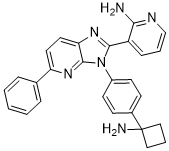
Miransertib(ARQ-092) is an orally bioavailable, selective, and potent allosteric Akt inhibitor with IC50s of 2.7 nM, 14 nM and 8.1 nM for Akt1, Akt2, Akt3, respectively.
In vitro: ARQ-092 demonstrates high enzymatic potency against Akt1, Akt2 and Akt3, as well as potent cellular inhibition of Akt activation and the phosphorylation of the downstream target PRAS40. ARQ-092 shows strong affinity for un-phosphorylated fulllength Akt1 and potently inhibited the phosphorylated form of full-length Akt isoforms. In a large panel of cell lines derived from various tumor types, ARQ-092 shows potent anti-proliferative activity in cell lines containing PIK3CA/PIK3R1 mutations compared to those with wild-type (wt) PIK3CA/PIK3R1 or PTEN loss. ARQ-092 shows excellent inhibition of p-Akt (S473) and p-Akt (T308) in both AN3CA and A2780 cells.
In vivo: ARQ-092 (po at 100 mg/kg, iv at 5 mg/kg) in a mouse pharmacokinetic study shows an oral bioavailability of 23%. ARQ-092 results in 99%, 95% and 58% reductions in p-Akt (S473), p-Akt (T306) and p-PRAS40 (T246), respectively, after tumor-bearing mice are treated with 100 mg/kg po. The inhibition of phosphorylation is sustained at eight hours. The plasma concentration of ARQ-092 at one hour is 2.1 μM and decreased to 0.26 μM at 8 hours, while in the tumor, the concentration is 21.0 μM at one hour and 9.6 μM at 8 hours. Treatment of the SHP2Y279C/+ mice with ARQ-092 normalizes the hypertrophic cardiomyopathy (HCM) phenotype as early as 2 weeks following treatment, with levels comparable to those in SHP2+/+ at this time point.
| Cell Experiment | |
|---|---|
| Cell lines | AN3CA and A2780 cells |
| Preparation method | AN3CA and A2780 cells are obtained from the ATCC. AN3CA cells are cultured in DMEM, and A2780 cells are cultured in RPMI supplemented with 10% FBS, 100 units/mL Penicillin, 100 μg/mL Streptomycin, and 2 mM Glutamine at 37 °C under 5% CO2. Cells are plated in 96-well plates at 2,000-10,000 cells/well, cultured for 24 h, and treated with the test compound for 72 h at a final DMSO concentration no greater than 0.5% v/v. PMS stock reagent (0.92 mg/mL in DPBS) is diluted 20-fold in MTS stock reagent (2 mg/mL in DPBS), and this MTS/PMS mixture is diluted 5-fold into each well of the 96-well plate. The plates are incubated for 3-4 h, and the absorbance of formazan is measured at 490 nm. The data are normalized to the untreated controls, the dose-response curves are fit to a four-parameter logistic equation, and the IC50 values are determined. All IC50 values reported are the geometric mean of at least two independent determinations. |
| Concentrations | final DMSO concentration no greater than 0.5% v/v |
| Incubation time | 72 h |
| Animal Experiment | |
|---|---|
| Animal models | SHP2Y279C/+ mice |
| Formulation | dissolved in 0.01 M phosphoric acid (vehicle) at a concentration of 20 mg/mL and filter sterilized |
| Dosages | 100 mg/kg body weight |
| Administration | oral gavage |
| Molecular Weight | 432.52 |
| Formula | C27H24N6 |
| CAS Number | 1313881-70-7 |
| Solubility (25°C) | DMSO ≥ 10 mg/mL |
| Storage |
Powder -20°C 3 years ; 4°C 2 years In solvent -80°C 6 months ; -20°C 1 month |
| Species | Mouse | Rat | Rabbit | Guinea pig | Hamster | Dog |
| Weight (kg) | 0.02 | 0.15 | 1.8 | 0.4 | 0.08 | 10 |
| Body Surface Area (m2) | 0.007 | 0.025 | 0.15 | 0.05 | 0.02 | 0.5 |
| Km factor | 3 | 6 | 12 | 8 | 5 | 20 |
| Animal A (mg/kg) = Animal B (mg/kg) multiplied by | Animal B Km |
| Animal A Km |
For example, to modify the dose of Compound A used for a mouse (20 mg/kg) to a dose based on the BSA for a rat, multiply 20 mg/kg by the Km factor for a mouse and then divide by the Km factor for a rat. This calculation results in a rat equivalent dose for Compound A of 10 mg/kg.
| Related Akt Products |
|---|
| LY2780301
LY2780301 is an oral dual-target inhibitor of AKT/RSK that binds to and inhibits the activity of Akt, thereby inhibiting the PI3K/Akt signaling pathway, which in turn inhibits cell proliferation and induces apoptosis in tumor cells, and possesses antitumor activity. |
| Akt/SKG Substrate Peptide
Akt/SKG Substrate Peptide is a synthetic peptide suitable as a substrate for Akt/PKB, which is not phosphorylated by p70S6K or MAPK1. |
| Adropin (34-76) (human, mouse, rat)
Adropin (34-76) (human, mouse, rat) regulates fuel selection preferences in skeletal muscle. |
| Apoptin-derived peptide
Apoptin-derived peptide is an antitumor polypeptide with cytotoxicity. |
| TAT-TCL1-Akt-in
TAT-TCL1-Akt-in is an Akt inhibitor. |


Products are for research use only. Not for human use. We do not sell to patients.
© Copyright 2010-2023 AbMole BioScience. All Rights Reserved.
